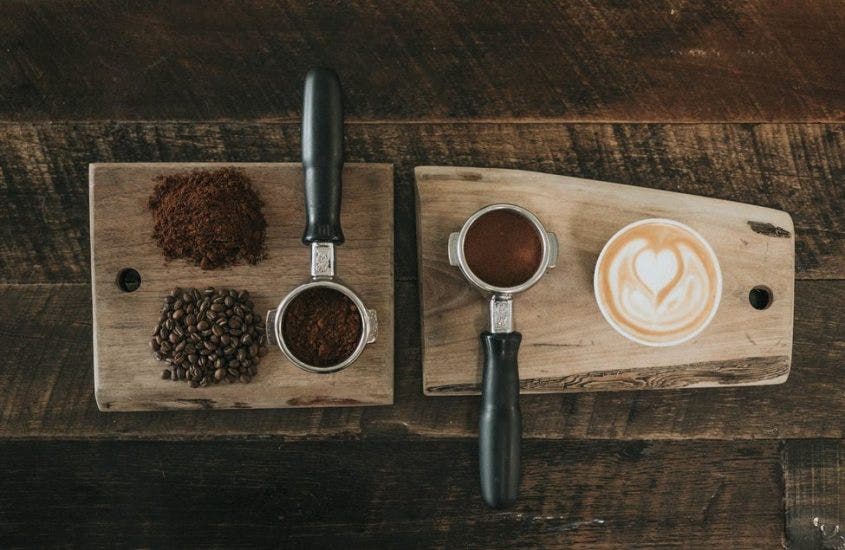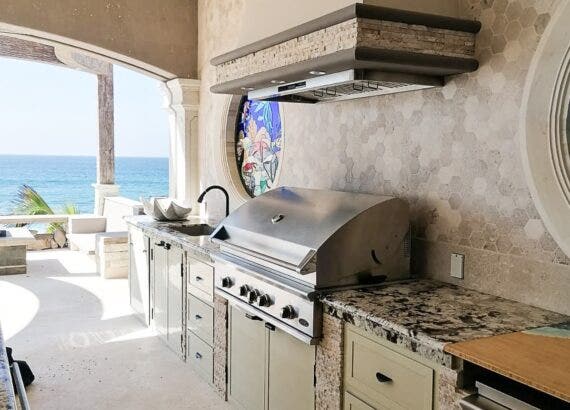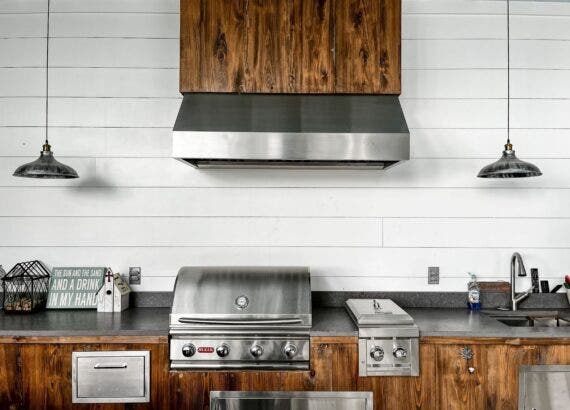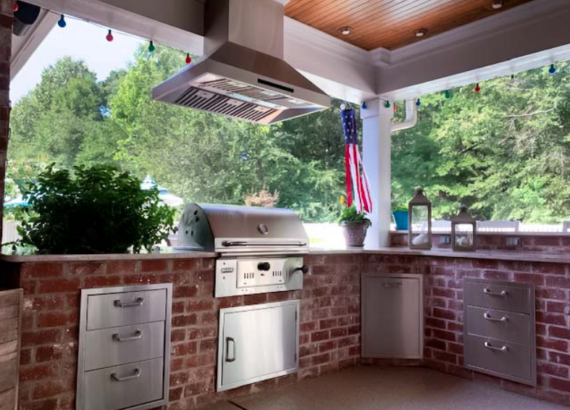How To Grind Coffee Beans For Espresso

It’s Saturday morning and you’re getting ready for the glorious weekend. You go into your pantry and grab the fresh coffee you bought yesterday in anticipation. You open it up and prepare to smell that fresh, ground espresso coffee. But, it’s actually coffee beans.
What do you do now? After all, you’ve already spent the money and the time picking the beans out. You try to blend them in a blender, but that won’t do with espresso.
Espresso grind needs to be a fine grain and blenders won’t do the trick. Mincing them with a knife or crushing them with a mortar and pestle won’t work well either. Luckily, we have a solution for you: use a burr grinder.
We’ll show you how to grind coffee beans for espresso using a burr grinder in just six steps.
Table of Contents
Grab Your Burr Grinder and Let’s Go!
For this type of coffee grind, you will need a burr grinder. Buyer beware, the similar blade grinders are far different from burr grinders. They do not keep a consistent grind. Blade grinders are more like a blender; we’ll cover that in a later section.
Blade grinders also generally heat the coffee, changing the final flavor when brewing is complete. Stay away from them when grinding coffee for espresso.
One of the more common brands of burr grinders on the market today is Baratza. They sell the standard Baratza Encore and the more expensive Baratza Virtuoso.
Consider investing in one of these grinders if you want to grind your own coffee beans, especially if you’re brewing espresso. Remember, no two coffee burr grinders are the same, so pay attention to your user manual.
Now, grab (or buy) your burr grinder, and let’s get into the steps.
Step 1: Check Your Coffee
Check your coffee and make sure it’s a dark roast coffee bean. Espresso coffee needs to be a dark roast. You will enjoy all the smooth finishes and acidic taste in your espresso from the darker roast.
Lighter roasts do not have the same taste. They will taste sour if you grind them as espresso coffee.
Step 2: Set Your Burr Grinder
It’s important to set your burr grinder to the correct setting. Most burr grinders will have a setting for espresso grinds. Check your user manual to learn the settings. For the Baratza Encore and the Virtuoso, the best setting for espresso will be either four or five.
Step 3: Get Your Coffee Beans
Measure out your coffee beans and place them in the hopper. If you’re a beginner, use small quantities of beans first. We recommend using a quarter cup for your first time and no more than a full cup.
Step 4: Check Your Grind Setting
You may have bumped the hopper and moved the setting. Check and make sure it’s correct!
Step 5: Turn Your Burr Grinder On
Now, it’s time. Turn your burr grinder on and let it run its cycle. You’ll get your ground coffee in the container on the bottom.
Step 6: Scoop and Brew!
Now, you’re ready to brew your coffee! Scoop out the desired amount for your espresso machine and brew your coffee. If you have leftover grounds, seal them in an airtight, dark container and store in a dark place. Use them the next day, or as soon as possible for the best freshness.
So, Why A Burr Grinder?
One of the common misconceptions is that burr grinders are the same as blade grinders. But, they are meant for different purposes.
Blade grinders work like blenders. They chop up whatever is on the bottom the best, and the food (or coffee beans) on the top doesn’t get chopped as nicely. You may not notice it in smoothies with ice, fresh fruit, and milk. But, with coffee, you’ll notice a consistent difference.
Because of an inconsistent grind, some grounds will be over-extracted and some, under-extracted. Furthermore, the blade for blade grinders is metal, so it will heat up quickly. Your grounds may get burnt too, which will change the complexion of the roast.
With burr grinders, this doesn’t happen. The two cutting discs, or burrs, cut through the beans quicker. They’re exposed to much less heat during the grinding process. And, what’s more, the burr grinder has several settings. The distance between the two burrs dictates how fine your grind will be.
The higher the setting, the larger the coffee grounds. For example, a French press grind will be around #30 on the Baratza machines we mentioned, and a cold brew will be #40. This is because these grinds need to be bigger during the extraction process! There will be some trial and error with certain bean types, roasts, and numbers. So, refer to your user manual for instructions.
But Why Does Grind Size Matter?
Depending on how you plan to brew your coffee, the grind size is the most important element for brewing a perfect cup of joe. Because hot water flows through the coffee grounds to extract the flavor, brew time and grind size matter a lot.
If your coffee grind is too large, the brewing process will be under-extracted, meaning the brew didn’t capture the full flavor of the grinds. Usually, the drink will taste quite sour and watered down. This is like going to a fast-food restaurant and they fill your soda with ice.
Now, you may be thinking that it’s possible to have a grind too big. But, if it’s too small, you’ll still have a flavor-packed cup, right? Wrong! You’ve just over-extracted your coffee and it’s most likely bitter. Small coffee grounds result in a strong cup of coffee and large grounds make it watered down.
Coffee Roasts: Different Types
There are three different types of roasts: light roast, medium roast, and dark roast. Sometimes there are light-medium and medium-dark roasts, too. Each roast tastes slightly different. But, there are some coffee grinds that can only be made with a specific type of roast.
We mentioned above how espresso needs dark roast for brewing; this is because the brewing process is so short! An espresso brew can take as little as twenty seconds and as long as forty seconds.
Because of this, it needs a fine grind and dark roasted coffee. When the water flows through the coffee grounds, it’s able to extract a lot of flavor in a little amount of time.
On the other hand, larger, coarser grinds are needed for cold brews or french press coffee makers. This is needed especially for cold brew coffees because the water is cold. To avoid over-extraction, they need a larger, coarser grind. It slowly pulls out the flavor from the grounds.
And, because of the long extraction time, generally, the roast is lighter, so the coffee doesn’t taste bitter.
You may be able to figure out medium grinds by now. They generally require a medium roast, too! This isn’t always the case, though. You can have lighter roasts or darker roasts with a medium grind. To compensate for different kinds of roasts, the brewing time may be longer for lighter roasts and shorter for darker roasts.
Now You’re Ready For Coffee!
So, now you know everything about grinding coffee for espresso, and the best types of roasts to use. To recap, a burr grinder is your best option for grinding espresso, and it’s also helpful for the other types of grinds we’ve mentioned!
All for an affordable price, you’ll be on your way to building your own coffee bar. If you want even more inspiration on building your own coffee bar or coffee station, check out our article on building your very own coffee station in your home!
Make sure you have your roasting type down, too. Remember that some grinds need specific roasts, but not all roasts need a specific grind.
For those of you that may have leftover coffee beans or grinds, check out our article on how to store coffee beans and coffee grinds. We also detail how long both beans and grounds will last!
Finally, if you want to learn how to brew Chemex coffee, check out this article. We break down step-by-step how to brew that perfect cup of morning coffee.
Thanks for reading!







Comments are closed.